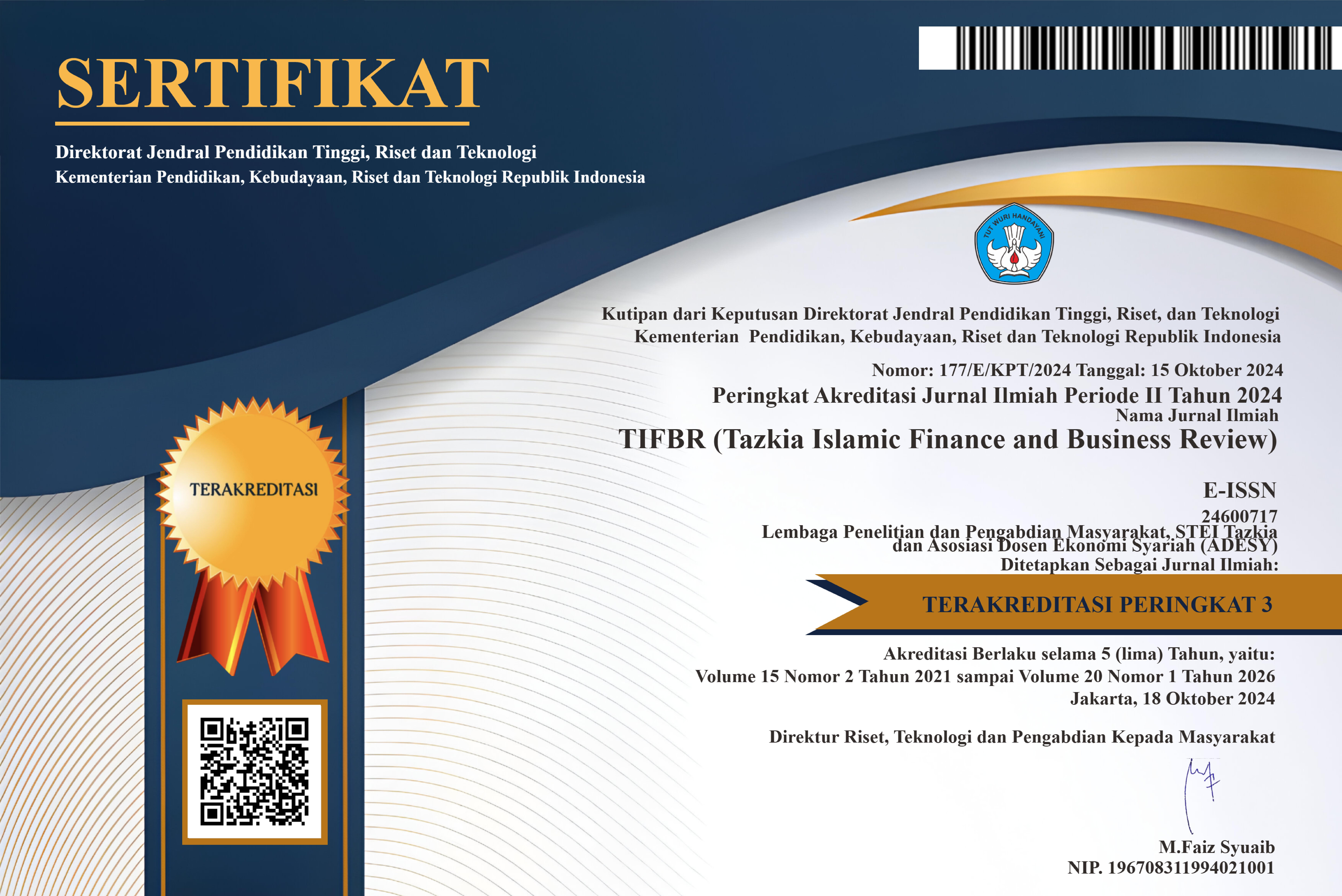Improving Performance of Zakat Institution in Poverty Alleviation: Balanced Scorecard Approach
DOI:
https://doi.org/10.30993/tifbr.v14i2.253Keywords:
Performance, Zakat Institution, Balanced Scorecard, Poverty AlleviationAbstract
The purpose of this study is to develop a performance improvement model of Zakat Institution in Indonesia (OPZIS) using four balanced scorecard perspectives in poverty alleviation. The model is examined by using Structural Equation Modeling (SEM) analysis. Respondents of this study was 100 employees of 11 Zakat Institution, 100 muzzaki and 100 mustahiq. The results of this study prove that the Balanced Scorecard approach as a strategic management model can improve Zakat Institution performance. The quality of Zakat Institution performance is influenced by the organization's ability to grow and become a learning organization with training and support from supervisors. Good internal processes are created by employee satisfaction and loyalty, which ultimately affects the quality of customer service. Good quality customer service will affect customer satisfaction, which in turn, customers become more loyal and affect Zakat Institution financial performance. High financial performance will increase the contribution of Zakat Institution in poverty alleviation. This is because Zakat Institution is able to properly channel the funds to those entitled to receive it, namely the poor.
References
Badan Pusat Statistik Provinsi Daerah Istimewa Yogyakarta. 2014. Laporan Eksekutif Sensus Penduduk, Provinsi DIY Tahun 2014.
Baylor, K.M. 2010. The Influence of Intrinsic & Extrinsic Job Satisfaction and Affective Commitment on the Intention to Quit for Occupations Characterized by High Voluntary Atrition, Dissertation: New Southeastern University.
Belás, J., & Gabčová, L., (2016). The Relationship among Customer Satisfaction, Loyalty and Financial Performance of Commercial Banks. Ekonomics and Management. 19(1):132-147.
Fithriyyah. (2010). Analisis Persepsi dan Sikap Muzzaki dalam Membayar Zakat, Thesis: Insitut Pertanian Bogor.
FOZ (Forum Zakat). (2012). Cetak Biru Pengembangan Zakat Indonesia 2011-2015, Forum Zakat (FOZ), Jakarta.
Isyandi. 2004. Manajemen Sumber Daya Manusia dalam Perspektif Global, Pekanbaru: UNRI, Press.
Keisidou, E., Sarigiannidis, L., Maditinos, D. I., & Thalassinos, E. I. (2013). Customer Satisfaction, Loyalty and Financial Performance. International Journal of Bank Marketing, 31(4), 259–288. doi:10.1108/ijbm-11-2012-0114.
Lee, S. M., Lee, D., & Kang, C.-Y. (2012). The Impact of High-Performance Work Systems in The Health-Care Industry: Employee Reactions, Service Quality, Customer Satisfaction, and Customer Loyalty. The Service Industries Journal, 32(1), 17–36. doi:10.1080/02642069.2010.545397.
Loke, S.P., Taiwo, A.A., Salim, H.M., & Downe, A.G. (2011). Service Quality and Customer Satisfaction in a Telecommunication Service Provider, International Conference on Financial Management and Economics, pp.24-29.
Mahsun, M. (2012). Pengukuran Kinerja Sektor Publik, Edisi 1, Yogyakarta: Fakultas Ekonomi UGM.
Maryatmo. (2012). Kebijakan dan Strategi pembangunan Ekonomi DIY, Yogyakarta: Forum Diskusi Ekonomi, Universitas Atmajaya.
Mulyadi. (2005). Sistem Manajemen Strategik Berbasis Balance Scorecard, Yogyakarta: UPP AMP YKPN.
Mosahab, R., Mahamad, O., & Ramayah, T. (2010). Service Quality, Customer Satisfaction and Loyalty: A Test of Mediation. International Business Research, 3(4). doi:10.5539/ibr.v3n4p72.
Parasuraman, A., Zeithaml, V.A & Berry. L.L. (1985). A Conceptual Model of Service Quality and Its Implication for Future Research, Journal of Marketing, Vol. 49, pp. 41-50.
Podsakoff, P. M., MacKenzie, S. B., Paine, J. B., & Bachrach, D. G. 2000. Organizational Citizenship Behaviors: A Critical Review of The Theroetical and Empirical Literature and Suggestions for Future Research. Journal of Management, 26(3), 513–563. https://doi.org/10.1177/014920630002600307.
Pohl, S., & Galletta, M. (2017). The Role of Supervisor Emotional Support on Individual Job Satisfaction: A Multilevel Analysis. Applied Nursing Research, 33, 61–66. doi:10.1016/j.apnr.2016.10.004.
Rachel, W.Y.Yee, Andy, C.L. Yeung & Edwin Cheng, T.C. (2013). The Impact of Employee Satisfaction on Quality and Profitability in High Contact Service Industries, Journal of Extension, Vol. 52, No.3.
Saidani, B., & Arifin, S. (2013). Pengaruh Kualitas Produk dan Kualitas Layanan terhadap Kepuasan Konsumen dan Minat Beli pada Ranch Market. JRMSI - Jurnal Riset Manajemen Sains Indonesia, 3(1), 1-22.
Smith, R.E., & Wright, W.F. (2004). Determinants of Customer Loyalty and Financial Performance, Journal of Management Accounting Research, 16(1):183-205.
Sulastiningsih & Wikaningtyas, S.U. (2013). Strategi Pengumpulan Zakat Organisasi Pengelola Zakat di Provinsi DIY, Laporan Penelitian, Yogyakarta: LP2M STIE Widya Wiwaha.
Tsourela, M, Mouza A.M, & Paschalouds, D. (2008). Extrinsic Job Satisfaction of Employee, Regarding Intention to Leave Work Position: A Survey in Small & Medium Entrepreneur, MIBES, pp.249-261.
Undang-Undang Republik Indonesia, Nomor 23, Tahun 2011. (2012). Tentang Pengelolaan Zakat, Badan Amil Zakat Nasional DIY.
Downloads
Published
How to Cite
Issue
Section
License

Tazkia Islamic Finance and Business Review (TIFBR) is licensed under a Creative Commons Attribution-NonCommercial 4.0 International License.
Authors who publish with this journal agree to the following terms:
- Authors retain copyright and grant the journal right of first publication with the work simultaneously licensed under a Creative Commons Attribution License that allows others to share the work with an acknowledgment of the work's authorship and initial publication in this journal.
- Authors are able to enter into separate, additional contractual arrangements for the non-exclusive distribution of the journal's published version of the work (e.g., post it to an institutional repository or publish it in a book), with an acknowledgment of its initial publication in this journal.
- Authors are permitted and encouraged to post their work online (e.g., in institutional repositories or on their website), as it can lead to productive exchanges, as well as earlier and greater citation of published work (See the Effect of Open Access).
















